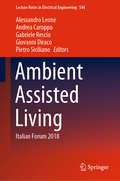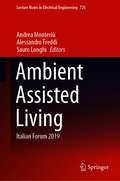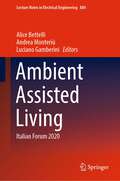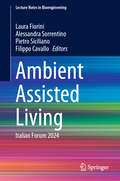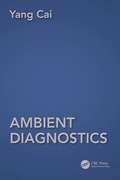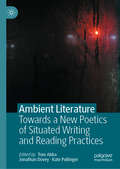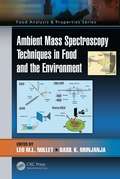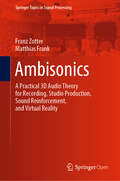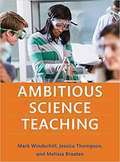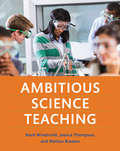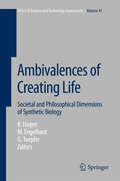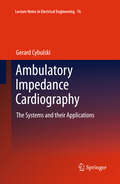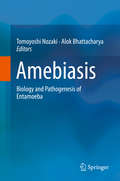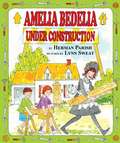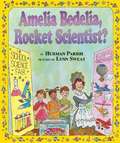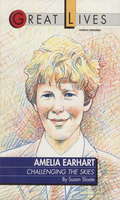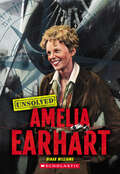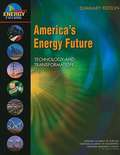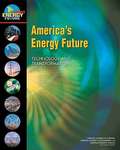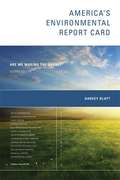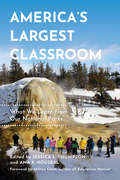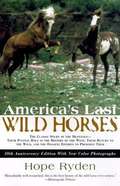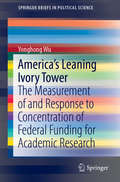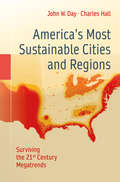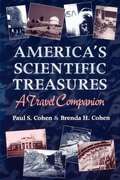- Table View
- List View
Ambient Assisted Living: Italian Forum 2018 (Lecture Notes in Electrical Engineering #544)
by Pietro Siciliano Alessandro Leone Andrea Caroppo Gabriele Rescio Giovanni DiracoThis book documents the state of the art in the field of ambient assisted living (AAL), highlighting the impressive potential of novel methodologies and technologies to enhance well-being and promote active ageing. The coverage is wide ranging, with sections on care models and algorithms, enabling technologies and assistive solutions, elderly people monitoring, home rehabilitation, ICT solutions for AAL, living with chronic conditions, robotic assistance for the elderly, sensing technologies for AAL, and smart housing. The book comprises a selection of the best papers presented at the 9th Italian Forum on Ambient Assisted Living (ForitAAL 2018), which was held in Lecce, Italy, in July 2018 and brought together end users, technology teams, and policy makers to develop a consensus on how to improve provision for elderly and impaired people. Readers will find that the expert contributions offer clear insights into the ways in which the most recent exciting advances may be expected to assist in addressing the needs of the elderly and those with chronic conditions.
Ambient Assisted Living: Italian Forum 2019 (Lecture Notes in Electrical Engineering #725)
by Sauro Longhi Andrea Monteriù Alessandro FreddiThis book documents the state of the art in the field of ambient assisted living (AAL), highlighting technologies and services which aim to improve health and quality of life, while promoting active aging. The coverage is wide ranging, with topical sections devoted to human monitoring, smart living services, biomedical and robotic solutions, including different case studies and real-world examples where assistive technologies are successfully applied. The book comprises a selection of the best, refereed papers presented at the 10th Italian Forum on Ambient Assisted Living (ForItAAL), held in Ancona, Italy, in June 2019, which represents the annual event that involves the Ambient Assisted Living Italian Association and brought together researchers, technology teams, policy makers, and stake-holders. Readers will find that the expert contributions offer clear insights into the ways in which the most recent exciting advances may be expected to assist in addressing the needs of the elderly and those with chronic conditions.
Ambient Assisted Living: Italian Forum 2020 (Lecture Notes in Electrical Engineering #884)
by Luciano Gamberini Andrea Monteriù Alice BettelliThis book provides state-of-the-art information on ambient assisted living (AAL), and focuses on technologies, services, living spaces, policies, and interventions to promote health, improve quality of life, and active aging. It includes various research contributions, case studies, and projects where assistive technologies are successfully applied in the field, and it covers a wide range of topics: Tailoring products and services to the Aging society, Bio-data and Artificial sensing AAL scenarios, Cognition, and Technologies, and Designing for Inclusion and Well-Being. The volume gathers the refereed proceedings of the 11th Italian Forum on Ambient Assisted Living (AAL), ForItAAL2020. This annual event involves companies, researchers, and stakeholders involved in the field of Ambient Assisted Living, it took place online due to the pandemic situation of Covid-19, and was organized by the University of Padua through the Human Inspired Technologies Research Centre and the Regional Innovative Network “ICT for Smart and Sustainable Living” with the contribution of the Smart Living Technologies’ Cluster. With its wide-ranging contributions to the topic, the book will inspire the readers and the researchers to continue their exploration of AAL technologies to support the development of products and services that make a real difference in people’s daily lives.
Ambient Assisted Living: Italian Forum 2024 (Lecture Notes in Bioengineering)
by Pietro Siciliano Filippo Cavallo Laura Fiorini Alessandra SorrentinoThis book provides state-of-the-art information on ambient assisted living (AAL) and focuses on technologies, services, living spaces, policies, and interventions to promote health, improve quality of life, and active aging. It includes various research contributions, case studies, and projects where assistive technologies are successfully applied in the field, and it covers a wide range of topics: tailoring products and services to the aging society, bio-data and artificial sensing AAL scenarios, cognition, and technologies, and designing for inclusion and well-being. The book gathers the refereed proceedings of the 13th Italian Forum on Ambient Assisted Living (ForItAAL), held in Florence, Italy, on June 25–28, 2024. With its wide-ranging contributions to the topic, the book inspires the readers and the researchers to continue their exploration of AAL technologies to support the development of products and services that make a real difference in people’s daily lives.
Ambient Diagnostics
by Yang CaiAmbient Diagnostics addresses innovative methods for discovering patterns from affordable devices, such as mobile phones, watches, cameras, and game interfaces, to interpret multimedia data for personal health monitoring and diagnosis. This is the first comprehensive textbook on multidisciplinary innovations in affordable healthcare-from senso
Ambient Literature: Towards a New Poetics of Situated Writing and Reading Practices
by Kate Pullinger Tom Abba Jonathan DoveyThis book considers how a combination of place-based writing and location responsive technologies produce new kinds of literary experiences. Building on the work done in the Ambient Literature Project (2016–2018), this books argues that these encounters constitute new literary forms, in which the authored text lies at the heart of an embodied and mediated experience. The visual, sonic, social and historic resources of place become the elements of a live and emergent mise-en-scène. Specific techniques of narration, including hallucination, memory, history, place based writing, and drama, as well as reworking of traditional storytelling forms combine with the work of app and user experience design, interaction, software authoring, and GIS (geographical information systems) to produce ambient experiences where the user reads a textual and sonic literary space. These experiences are temporary, ambiguous, and unpredictable in their meaning but unlike the theatre, the gallery, or the cinema they take place in the everyday shared world. The book explores the potentiality of a new literary form produced by the exchange between location-aware cultural objects, writers and readers. This book, and the work it explores, lays the ground for a new poetics of situated writing and reading practices.
Ambient Mass Spectroscopy Techniques in Food and the Environment (Food Analysis & Properties)
by Leo M.L. Nollet Basil K. MunjanjaAmbient mass spectrometry—that is the use of mass spec but in the atmospheric environment—has been widely employed in food and environmental analysis. Ambient Mass Spectroscopy Techniques in Food and the Environment presents the theoretical underpinnings of mass spectrometry, and the benefits and pitfalls of ambient mass spectrometry, as well as the latest developments of the technique, in the analysis of food and environmental parameters. It describes methods that enable the detection of surface materials like waxes, alkaloids, flavors, or pesticides by plainly exposing the corresponding items to the ionization region of the interface, without harm to samples. Features: Explains the theoretical aspects of ambient mass spectrometry Describes how to use ambient MS techniques for food safety, authenticity, and traceability screening Lists the benefits of ambient MS in analysis of food and environmental parameters Covers recent developments of ambient MS in analysis of food and environmental parameters The specialized work provides insight to professionals practicing in food and the environment, including food scientists, food engineers, food biotechnologists, chemical engineers, and those working in research labs, universities, and government regulatory agencies.
Ambisonics: A Practical 3D Audio Theory for Recording, Studio Production, Sound Reinforcement, and Virtual Reality (Springer Topics in Signal Processing #19)
by Franz Zotter Matthias FrankThis open access book provides a concise explanation of the fundamentals and background of the surround sound recording and playback technology Ambisonics. It equips readers with the psychoacoustical, signal processing, acoustical, and mathematical knowledge needed to understand the inner workings of modern processing utilities, special equipment for recording, manipulation, and reproduction in the higher-order Ambisonic format. The book comes with various practical examples based on free software tools and open scientific data for reproducible research.The book’s introductory section offers a perspective on Ambisonics spanning from the origins of coincident recordings in the 1930s to the Ambisonic concepts of the 1970s, as well as classical ways of applying Ambisonics in first-order coincident sound scene recording and reproduction that have been practiced since the 1980s. As, from time to time, the underlying mathematics become quite involved, but should be comprehensive without sacrificing readability, the book includes an extensive mathematical appendix. The book offers readers a deeper understanding of Ambisonic technologies, and will especially benefit scientists, audio-system and audio-recording engineers.In the advanced sections of the book, fundamentals and modern techniques as higher-order Ambisonic decoding, 3D audio effects, and higher-order recording are explained. Those techniques are shown to be suitable to supply audience areas ranging from studio-sized to hundreds of listeners, or headphone-based playback, regardless whether it is live, interactive, or studio-produced 3D audio material.
Ambitious Science Teaching
by Jessica Thompson Mark Windschitl Melissa BraatenAmbitious Science Teaching outlines a powerful framework for science teaching to ensure that instruction is rigorous and equitable for students from all backgrounds. The practices presented in the book are being used in schools and districts that seek to improve science teaching at scale, and a wide range of science subjects and grade levels are represented. The book is organized around four sets of core teaching practices: planning for engagement with big ideas; eliciting student thinking; supporting changes in students’ thinking; and drawing together evidence-based explanations. Discussion of each practice includes tools and routines that teachers can use to support students’ participation, transcripts of actual student-teacher dialogue and descriptions of teachers’ thinking as it unfolds, and examples of student work. The book also provides explicit guidance for “opportunity to learn” strategies that can help scaffold the participation of diverse students. Since the success of these practices depends so heavily on discourse among students, Ambitious Science Teaching includes chapters on productive classroom talk. Science-specific skills such as modeling and scientific argument are also covered. Drawing on the emerging research on core teaching practices and their extensive work with preservice and in-service teachers, Ambitious Science Teaching presents a coherent and aligned set of resources for educators striving to meet the considerable challenges that have been set for them.
Ambitious Science Teaching
by Jessica Thompson Mark Windschitl Melissa Braaten2018 Outstanding Academic Title, ChoiceAmbitious Science Teaching outlines a powerful framework for science teaching to ensure that instruction is rigorous and equitable for students from all backgrounds. The practices presented in the book are being used in schools and districts that seek to improve science teaching at scale, and a wide range of science subjects and grade levels are represented. The book is organized around four sets of core teaching practices: planning for engagement with big ideas; eliciting student thinking; supporting changes in students&’ thinking; and drawing together evidence-based explanations. Discussion of each practice includes tools and routines that teachers can use to support students&’ participation, transcripts of actual student-teacher dialogue and descriptions of teachers&’ thinking as it unfolds, and examples of student work. The book also provides explicit guidance for &“opportunity to learn&” strategies that can help scaffold the participation of diverse students. Since the success of these practices depends so heavily on discourse among students, Ambitious Science Teaching includes chapters on productive classroom talk. Science-specific skills such as modeling and scientific argument are also covered. Drawing on the emerging research on core teaching practices and their extensive work with preservice and in-service teachers, Ambitious Science Teaching presents a coherent and aligned set of resources for educators striving to meet the considerable challenges that have been set for them.
Ambivalences of Creating Life: Societal and Philosophical Dimensions of Synthetic Biology (Ethics of Science and Technology Assessment #45)
by Margret Engelhard Kristin Hagen Georg Toepfer"Synthetic biology" is the label of a new technoscientific field with many different facets and agendas. One common aim is to "create life", primarily by using engineering principles to design and modify biological systems for human use. In a wider context, the topic has become one of the big cases in the legitimization processes associated with the political agenda to solve global problems with the aid of (bio-)technological innovation. Conceptual-level and meta-level analyses are needed: we should sort out conceptual ambiguities to agree on what we talk about, and we need to spell out agendas to see the disagreements clearly. The book is based on the interdisciplinary summer school "Analyzing the societal dimensions of synthetic biology", which took place in Berlin in September 2014. The contributions address controversial discussions around the philosophical examination, public perception, moral evaluation and governance of synthetic biology.
Ambulatory Impedance Cardiography: The Systems and their Applications (Lecture Notes in Electrical Engineering #76)
by Gerard CybulskiThe book is divided in 4 parts. In the first one, the importance of the analysis of the cardiac dynamics using the ambulatory monitoring technique is presented. The second part contains the description of foundations of impedance cardiography (ICG), the models used to describe the ICG technique and the description of available systems for ambulatory monitoring of cardiac hemodynamics. The third part is devoted to the validation of the ambulatory ICG method, the verification of the quality of long term ICG recordings and the discussion of the limitations of this technique. In the last part, some clinical and research applications of the ICG ambulatory monitoring are presented. The simultaneous recordings of electrocardiogram (ECG) and ICG in the transient cardiac arrhythmia events illustrate the potential applications of that method for quantitative analysis of hemodynamics when the implementation of the stationary methods would be either difficult or not possible to do. The book is followed by references, alphabetical index and appendices containing the technical data of the available systems for portable monitoring of cardiac hemodynamics.
Amebiasis: Biology and Pathogenesis of Entamoeba
by Tomoyoshi Nozaki Alok BhattacharyaThis book documents and presents new developments in the study of amebiasis, one of the neglected tropical diseases. Nearly 50 million people worldwide are infected with the pathogen Entamoeba histolytica, causing large-scale morbidity and mortality particularly in developing countries. This book will help clinicians for better diagnosis and management of the disease, researchers for initiating research projects on some of the poorly understood aspects of the disease and the pathogen, and students for updating their knowledge. The subjects covered range from genomics and molecular and cell biology to drug resistance and new drug development, highlighting major advances in recent years in our understanding due to rapid progress in genomic and other biomedical technologies, such as visualization of molecular processes. Most of the chapters provide recent information based on latest publications. A few chapters describe some of the critical methodological issues that will be helpful for students and researchers interested in getting into the field. The contributing authors include almost all the active researchers and clinicians from around the world. This book will be a useful primary material and a valuable source of information for anyone interested in understanding amebiasis, its diagnosis, and treatment. It will also be useful to those who are interested in learning about the biology of early branching eukaryotes and protist pathogens.
Amelia Bedelia Under Construction (I Can Read! #22)
by Herman ParishWhen Amelia Bedelia babysits for the Hardy family, she become involved in some unexpected remodeling of their house.
Amelia Bedelia, Rocket Scientist
by Herman ParishHousekeeper Amelia Bedelia wreaks havoc when she volunteers to help out at the school science fair.
Amelia Earhart
by Susan SloateThe Great Lives SeriesWitness history in the making as you turn the pages of time and discover the fascinating lives of famous explorers, leaders of 20th century politics and government, and great Americans.Amelia EarhartChallenging the SkiesWhen Amelia Earhart vanished over the Pacific Ocean in 1937 during her attempt to make the first round-the-world flight via the equator, it sparked one of the century's greatest mysteries. Did she crash? Was she taken prisoner by the Japanese? Was she on a spying mission for the U.S government? Is she alive today?The First Woman To Fly Across the Atlantic!Amelia Earhart: Challenging the Skies is the story of a compelling woman whose achievements spurred the growth of commercial aviation and furthered the cause of women's rights, as well. Accompany Amelia into the dangerous skies of the first days of flight and watch as she tames them with a daring all her own!The Great Lives Series has been developed under the auspices of Dr. Frank Moretti, Ph.D., Associate Headmaster of The Dalton School in New York City; Dr. Paul Mattingly, Ph.D., Professor of History at New York University; and Barbara Smith, M.S., Assistant Superintendent of the Los Angeles Unified School District.From the Trade Paperback edition.
Amelia Earhart (Unsolved)
by Dinah WilliamsDiscover the unsolved mystery of Amelia Earhart’s disappearance in this beautifully illustrated book for kids, accessible for all readers!Amelia Earhart is famous for being the first woman to fly solo across the Atlantic Ocean. On July 2, 1937, while attempting to fly around the world, she vanished. Can someone just disappear? Decide for yourself with actual clues, facts, and photographs. This real unsolved mystery will unfold with simple text and exciting visuals.ABOUT THIS SERIES:Take a deep dive into some of the most unbelievable but real unsolved mysteries from history with this brand-new series of books. Can someone just disappear? Is there such a thing as a buried treasure? Does Bigfoot exist? Each book in this series focuses on one unsolved mystery and describes its main events chronologically. Readers will follow along as the exciting narrative uncovers real historical clues. Multiple theories will be presented providing an opportunity for readers to draw their own conclusions. The most up-to-date facts and relevant modern-day discoveries will be included to allow for real-world connections. Perhaps you will be the one to solve an unsolved mystery!
America'S Energy Future: Technology and Transformation - Summary Edition
by National Academy of Science National Academy of Enegineering National Research Council of the National AcademiesEnergy touches our lives in countless ways and its costs are felt when we fill up at the gas pump, pay our home heating bills, and keep businesses both large and small running. There are long-term costs as well: to the environment, as natural resources are depleted and pollution contributes to global climate change, and to national security and independence, as many of the world's current energy sources are increasingly concentrated in geopolitically unstable regions. The country's challenge is to develop an energy portfolio that addresses these concerns while still providing sufficient, affordable energy reserves for the nation. The United States has enormous resources to put behind solutions to this energy challenge; the dilemma is to identify which solutions are the right ones. Before deciding which energy technologies to develop, and on what timeline, we need to understand them better. The summary edition of America's Energy Future summarizes the full analyses of the potential of a wide range of technologies for generation, distribution, and conservation of energy found in the complete edition of America's Energy Future. This summary edition also succinctly considers technologies to increase energy efficiency, coal-fired power generation, nuclear power, renewable energy, oil and natural gas, and alternative transportation fuels. It assesses the associated impacts and projected costs of implementing each technology and categorizes them into three time frames for implementation.
America's Energy Future: Technology and Transformation
by National Academy of Science National Academy of Enegineering National Research Council of the National AcademiesEnergy touches our lives in countless ways and its costs are felt when we fill up at the gas pump, pay our home heating bills, and keep businesses both large and small running. There are long-term costs as well: to the environment, as natural resources are depleted and pollution contributes to global climate change, and to national security and independence, as many of the world's current energy sources are increasingly concentrated in geopolitically unstable regions. The country's challenge is to develop an energy portfolio that addresses these concerns while still providing sufficient, affordable energy reserves for the nation. The United States has enormous resources to put behind solutions to this energy challenge; the dilemma is to identify which solutions are the right ones. Before deciding which energy technologies to develop, and on what timeline, we need to understand them better. America's Energy Future analyzes the potential of a wide range of technologies for generation, distribution, and conservation of energy. This book considers technologies to increase energy efficiency, coal-fired power generation, nuclear power, renewable energy, oil and natural gas, and alternative transportation fuels. It offers a detailed assessment of the associated impacts and projected costs of implementing each technology and categorizes them into three time frames for implementation.
America's Environmental Report Card
by Harvey BlattA timely survey of the state of America's environment: how we can take action to achieve a sustainable future.
America's Largest Classroom: What We Learn from Our National Parks
by Jessica L. ThompsonOver the past 100 years, visitor learning at America’s national parks has grown and evolved. Today, there are over 400 National Park Service (NPS) sites, representing over eighty million acres. Sites exist in every US state and territory and are located on land, at sea, in remote areas, and in major urban centers. Every year, more than 300 million people visit national parks, and several million of them are children engaged in one of many educational programs hosted by the NPS.America’s Largest Classrooms offers insight and practical advice for improving educational outreach at national parks as well as suggestions for classroom educators on how to meaningfully incorporate parks into their curricula. Via a wide collection of case studies—ranging from addressing inclusivity at parks and public lands to teaching about science and social issues—this book illustrates innovations and solutions that will be of interest to nature interpreters, outdoor educators, and policy makers, as well as professors in the sciences writ large.
America's Last Wild Horses
by Hope RydenFrom the Book Jacket: "A richly researched and written book with an unusual appeal." -Publishers Weekly "This book is a treat for everyone who knows or cares about horses." -Cleveland Amory No wild animal captures the spirit of North America quite so powerfully as the wild horse-nor has any faced such diverse and potent enemies. In this provocative account, Hope Ryden-who helped to ensure the passage of the Wild and Free-Roaming Horse and Burro Act, which grants mustangs special protection-combs the history of these proud and noble horses; Descended from the Spanish horses ridden by the conquistadors, they evolved into the tough and intelligent ponies that Indians-and later, explorers and cowboys-learned to rely on. From the period when wholesale extermination of the buffalo was underway until recent times, commercial and political interests have sought to eliminate the wild horses as varmints. In the latest update to this classic story Ryden tells of the successes: and failures in the past ten years of regulation, and has added stunning new color photographs. The subject of a front-page article in The New York Times. when it was first published, america's last wild horses continues to be a compelling testament to the life of a uniquely American symbol of grace and wildness, and is a must read for horse lovers and Western history enthusiast everywhere.
America's Leaning Ivory Tower: The Measurement of and Response to Concentration of Federal Funding for Academic Research (SpringerBriefs in Political Science)
by Yonghong WuThis book will expand the body of literature on capacity-building in science and improve public understanding of the issues regarding geographical concentration of federal research funding. The federal government has been the primary sponsor of academic research in the U.S., and the peer-review system has been the primary mechanism for distributing federal government funding for research among universities. The peer-review system ensures the production of the best science by funding the most capable researchers in the country. As a result, federal research funding has been concentrated in high-capacity states where many of the most capable researchers reside. Despite official action - such as the implementation of the Experimental Program to Stimulate Competitive Research (EPSCoR), which targets low capacity jurisdictions for federal funding - the amount of resources going to each state for research is highly uneven. This book provides recommendations on how to improve policy design and program implementation for better research capacity-building outcomes. The book lends itself to a wide audience, as it does not focus entirely on high-level statistical analysis, but will have specific appeal to researchers in science policy, federal budgeting and higher education policy.
America's Most Sustainable Cities and Regions: Surviving the 21st Century Megatrends
by John W. Day Charles HallThis book takes you on a unique journey through American history, taking time to consider the forces that shaped the development of various cities and regions, and arrives at an unexpected conclusion regarding sustainability. From the American Dream to globalization to the digital and information revolutions, we assume that humans have taken control of our collective destinies in spite of potholes in the road such as the Great Recession of 2007-2009. However, these attitudes were formed during a unique 100-year period of human history in which a large but finite supply of fossil fuels was tapped to feed our economic and innovation engine. Today, at the peak of the Oil Age, the horizon looks different. Cities such as Los Angeles, Phoenix and Las Vegas are situated where water and other vital ecological services are scarce, and the enormous flows of resources and energy that were needed to create the megalopolises of the 20th century will prove unsustainable. Climate change is a reality, and regional impacts will become increasingly severe. Economies such as Las Vegas, which are dependent on discretionary income and buffeted by climate change, are already suffering the fate of the proverbial canary in the coal mine. Finite resources will mean profound changes for society in general and the energy-intensive lifestyles of the US and Canada in particular. But not all regions are equally vulnerable to these 21st-century megatrends. Are you ready to look beyond "America's Most Livable Cities" to the critical factors that will determine the sustainability of your municipality and region? Find out where your city or region ranks according to the forces that will impact our lives in the next years and decades. Find out how: ·resource availability and ecological services shaped the modern landscape ·emerging megatrends will make cities and regions more or less livable in the new century ·your city or region ranks on a "sustainability" map of the United States ·urban metabolism puts large cities at particular risk ·sustainability factors will favor economic solutions at a local, rather than global, level ·these principles apply to industrial economies and countries globally. This book should be cited as follows: J. Day, C. Hall, E. Roy, M. Moersbaecher, C. D'Elia, D. Pimentel, and A. Yanez. 2016. America's most sustainable cities and regions: Surviving the 21st century megatrends. Springer, New York. 348 p.
America's Scientific Treasures: A Travel Companion
by Paul S. Cohen Brenda H. CohenA fairly comprehensive travel guide that takes the reader to sites of scientific interest in the 48 contiguous states. Each state is represented by its own scientific treasures including museums, arboretums, zoos, national parks, planetariums, natural or technological points of interest and homes of famous scientists. Addresses, telephone numbers, travel directions, opening and closing dates, hours of entry, handicapped access, restaurants, fees, and the availability of tour guides is listed for each attraction.
